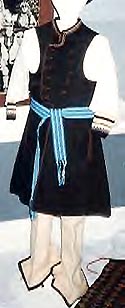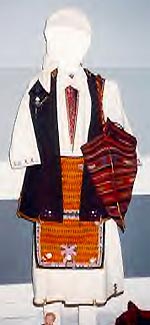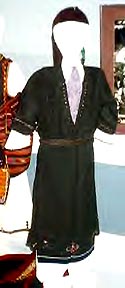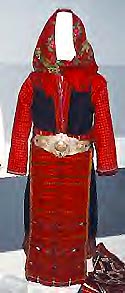
| |||||||
| |||||||
MAP | GREEK VERSION | ONLY TEXT | CREDITS |
 |
COSTUMES FROM MACEDONIA | |

|
ALONA The male costume of Alona is similar to the male costume found in both Akritas and Psaradhes. Generally, this costume style, with some variations made to it, is found throughout the region of Florina, Western Macedonia. The cotton undershirt hangs to just above the knee and is embroidered around the collar. Beneath the undershirt, unattached sleeves cover the forearm, and may also be embroidered if so desired. A sleeveless, black, woolen overcoat, the kiourdia, is also worn but not in the summer months. In Alona, as in the other areas of Macedonia, the old red hat or fesi has been replaced by a black toque of astrakhan or plush, the kape. This costume has served as model for the uniform of the Macedonian Fighters. |

|
FLORINA: AGHIA PARASKEVI The women's costume of Aghia Paraskevi is similar in style to the costumes of the surrounding villages. The white chemise is hand spun and woven from cotton, embroidered with a fine woolen thread around the hem line. Two heavier panels are added to the bottom of the back side only. The front of the chemise is open to just above the waistline revealing the dickey (or bib). The dickey is bordered by a simple piece of floral-patterned cotton and tied around the neck. The sleeveless overcoat is worn over the chemise and dickey. The overcoat, black in color, was white prior to the 1920's. However, there was a period of time where both colors were used. The cord-work on the overcoat is made with yellow and red threads. It is a very simple design, but because of the colors it is very appealing. The apron is a woven masterpiece. The pattern design is very complicated and is woven with red, yellow and black threads. The edges are adorned with ribbons and coins. The pattern design of the hand-knit leggings is also very complicated and is made using the same color scheme as the apron. The plain white scarf is folded in a triangle shape. The corner hangs down the back to just beneath the waistline, and is trimmed with coins and long fringes, embroidered with woolen or silk threads. |
|
FLORINA, TRIANTAFYLLIES The poor quality of the soil of the Florina plateaus, prevented the local residents from wearing clothing of expensive material. The nearby forest offered some resources, such as timber, charcoal and bee-keeping, but the people lived a life of deprivation and hardship. The women wove their own cotton and woolen cloth from which they sewed their simple, austere dresses. The white cotton chemise was embroidered around the hem line and on the sleeves with colored threads. The opening of the front of the chemise was bordered by brightly-colored fabric. A floral patterned jabot of bought fabric was placed at the opening of the bodice. A black woolen, sleeveless overcoat, the sigouni, was worn over this. This overcoat was embroidered around the neck and on the front with brightly-colored threads. The sash, approximately two meters in length, was made of black wool and tied around the waist at the top of the apron. The black and red apron was always home spun and woven. The simple black scarf, placed upon the head, was adorned with a string of pearls. These pearls were considered to be part of the dowry. Women of the Triantafyllies area can still be seen wearing their costumes on special occasions. | |

|
PSARADHES The Psaradhes region is among the very few regions in modern-day Greece, where many women still continue to wear their every-day folk dress and even their festival costume. The cotton chemise worn, similar in form to all chemises belonging to costumes using the siguni, are characterized by the old, traditional motifs sewn with the same stitches as found in the embroideries of Macedonia, Epirus, Thessaly, Attica, Boeotia and Euboea. In the past, the costume of the villages around Lake Prespa, Agios Germanos and Psaradhes was all white. Around the years 1930-1935, the women replaced the all-white bridal and festival costume with a black siguni and dark-colored apron, worn later only by middle-aged women. A decorative dickey, the tracila, draped over the bosom. A black, woolen, elbow-length overcoat was also worn. An apron, made of either black wool, a dark-colored velvet or brocade material, adorned with silver coins, tied over the waist and overcoat. Black stockings were always worn and a printed black scarf adorned the head. To accent the costume, pearls were worn around the neck; silver coins draped from the bosom down to the waist and up to the shoulders; and silver chains were used to grace the aprons. |

|
ORINI Orini consists of two villages, neighboring each other, known as Orini and Ano Orini. Both are mountainous villages, as their names imply - earlier they were known as the Phrastena - with Orini situated at an altitude of 750 meters and Ano Orini at 820 meters. The mountainous situation of the two villages, the agricultural nature of their economy, the restricted, "closed" life of the villagers and the absence of tourism - the road from Serres to the villages is for the most part only roughly paved - all have contributed effectively to the preservation of the villagers' traditional modes of life. Women's costumes of Orini, Ano Orini, and Xirotopos, Serres, are characterized by the same basic elements that make up the majority of village costumes in the Balkans (underdress, middle dress, overcoat, sash, apron, stockings and head kerchief). Visually, they immediately call to mind the costumes of Volakas, Drama and of those villages sharing similar costumes (Xiropotamos, Monastiraki etc.) Like all of the costumes of Greece, they differ according to the circumstances under which they worn (i.e. denoting every day wear, to mark festive or nuptial occasions, to denote single or married status). The kouralak, a small round box dressed with material of some kind and worn on the crown of the head, is an important accessory to the bridal headdress. |